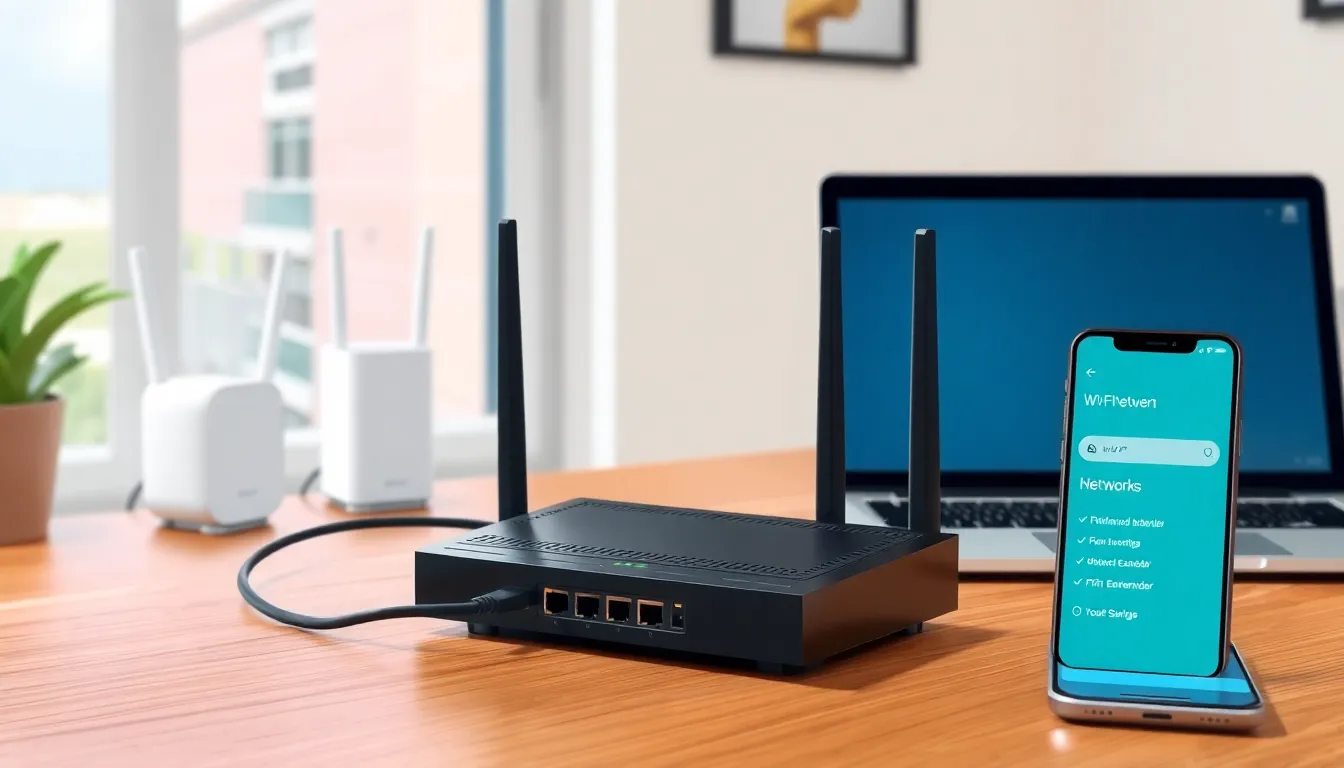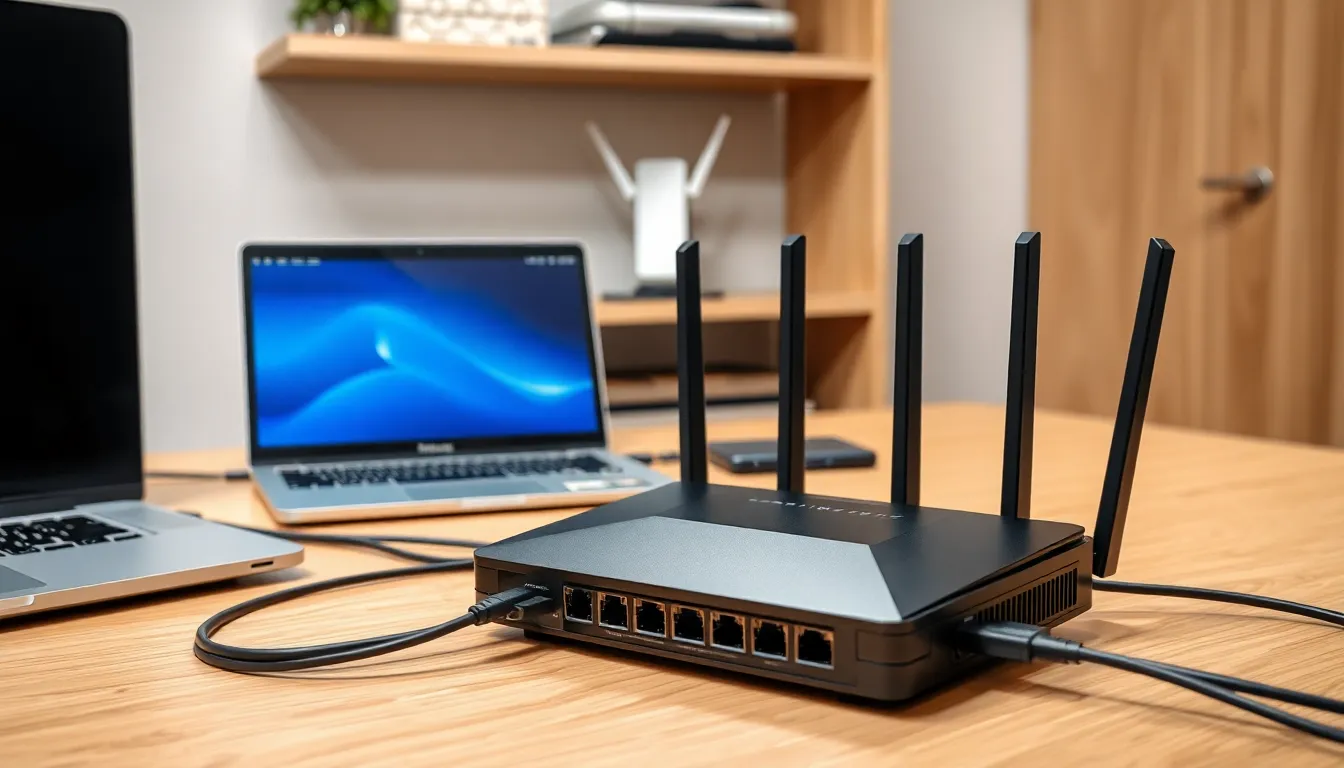In today’s world, a strong home network is as essential as a good cup of coffee. With multiple devices vying for attention, from smart TVs to gaming consoles, having a reliable connection can mean the difference between binge-watching the latest series and staring at a buffering wheel of doom. It’s time to take control of your digital domain and ensure your Wi-Fi is more reliable than your neighbor’s cat.
Table of Contents
ToggleUnderstanding Home Networking
Home networking refers to the practice of connecting multiple devices within a home to share resources and access the internet. This connection enhances the experience of using various digital devices simultaneously.
What Is Home Networking?
Home networking involves linking devices like computers, smartphones, smart TVs, and printers through wired or wireless connections. Users can create local area networks (LANs) to enable seamless communication and resource sharing among devices. A well-configured home network allows for printers to be accessed by multiple computers or enables streaming services on different smart TVs throughout the house.
Importance of Home Networking
Home networking plays a crucial role in modern households. It supports the simultaneous use of various devices, promoting an uninterrupted streaming and gaming experience. A robust network alleviates frustrations linked to slow connections, thereby enhancing productivity and entertainment. Security becomes essential as well, safeguarding personal information shared across devices. Establishing a strong home network is increasingly important as the number of connected devices continues to rise, ensuring that everyone in the household maintains reliable internet access.
Essential Components of a Home Network


A strong home network relies on several key components. Each plays a crucial role in ensuring smooth connectivity for multiple devices.
Routers and Modems
Routers and modems serve as the backbone of a home network. A modem connects directly to the internet service provider, providing access to the web. The router then distributes this internet connection to all devices in the home. Modern routers support higher speeds and multiple connections, enabling seamless streaming and gaming experiences. Configuring these devices properly enhances their performance and security, ensuring that all connected devices maintain reliable internet access.
Network Cables and Switches
Network cables and switches facilitate wired connections within a home network. Ethernet cables provide faster and more stable connections compared to Wi-Fi, crucial for devices like gaming consoles and desktop computers. Switches expand the number of devices that connect to a single router, allowing multiple computers or smart TVs to access the network simultaneously. Using high-quality cables and switches reduces latency and increases overall network efficiency.
Wi-Fi Extenders and Mesh Systems
Wi-Fi extenders and mesh systems enhance wireless coverage throughout the home. Extenders boost the existing Wi-Fi signal, helping eliminate dead zones in larger spaces. Mesh systems, consisting of multiple nodes, create a single, seamless network that ensures strong connectivity in every corner of the home. Each node communicates with the others to optimize signal strength, making them ideal for homes with multiple floors or dense walls. Proper placement of these devices significantly improves overall network performance.
Setting Up Your Home Network
Establishing a solid home network involves several key steps to ensure seamless connectivity. Start with the layout, move to configuring your router, and finally connect devices efficiently.
Planning Your Network Layout
Determining the layout of a home network begins with understanding device locations. Assess where computers, smart TVs, and gaming consoles reside. Place the router central to these devices to enhance signal distribution. Consider physical barriers like walls that may disrupt connectivity. Utilize tools such as network mapping apps to visualize coverage areas. Prioritize high-traffic areas for optimal performance.
Configuring Your Router
Optimizing router settings enhances network performance significantly. Access the router interface using its IP address through a web browser. Change default usernames and passwords for increased security. Enable WPA3 encryption to protect wireless transmissions. Adjust the channel settings to minimize interference from neighboring networks. Set up a guest network for visitors without compromising main access. Regularly update firmware to ensure the router runs efficiently.
Connecting Devices to Your Network
Connecting devices to the network is straightforward when following structured guidelines. Begin by using Ethernet cables for stationary devices like desktop computers and gaming consoles. For wireless devices, select the correct Wi-Fi network and enter the password. Ensure each device receives a dynamic IP address from the router. Manage connections through the router’s interface to prioritize bandwidth for essential devices. Monitor device performance and adjust configurations as necessary for a smooth experience.
Securing Your Home Network
Securing a home network is crucial for protecting devices and personal information from cyber threats. A strong security posture helps prevent unauthorized access and potential data breaches.
Importance of Network Security
Network security guards against a range of risks, including data theft and malicious attacks. Home networks often contain sensitive information, such as financial details and personal files. Unauthorized users can exploit weak security to gain access to devices. With the increase of smart home devices, the attack surface expands, making robust security essential. Families must prioritize safeguarding their networks to avoid the consequences of data exposure.
Common Security Measures
Implementing common security measures enhances home network safety. Changing the default router password helps protect against unauthorized access. WPA3 encryption secures wireless communications, making it difficult for intruders to intercept data. Regularly updating firmware ensures devices utilize the latest security patches. Setting up a guest network keeps visitors separated from personal devices, minimizing risks. Additionally, utilizing a virtual private network (VPN) adds another layer of protection while browsing, guarding personal information from potential threats.
Troubleshooting Common Network Issues
Home networks sometimes face a variety of issues that hinder performance. Identifying and resolving these problems can enhance connectivity and user experience.
Slow Internet Speeds
Slow internet speeds frustrate users across multiple devices. Factors affecting speed include congestion from numerous connected devices and outdated equipment. Using a wired connection instead of Wi-Fi can significantly improve performance for stationary devices. Checking bandwidth usage through router settings helps identify bandwidth hogs like streaming services. Regularly rebooting the router often clears temporary glitches that slow speeds. Ensuring firmware is up to date also plays a critical role in maintaining optimal performance. If slow speeds persist, consider upgrading the internet plan to meet household demands.
Connection Drops
Connection drops disrupt online activities and can impact productivity. Various causes for disconnections exist, including interference from walls or appliances and signal overload from too many devices. Changing the router’s location to a central, elevated area improves signal strength. Disconnecting idle devices from the network minimizes strain on resources. Checking for software updates ensures the router operates with the latest features and bug fixes. Additionally, adjusting the Wi-Fi channel reduces interference from neighboring networks. In persistent cases, replacing aging routers with more advanced models can provide substantial improvements in connectivity.
Establishing a strong home network is vital in today’s connected world. By understanding the components and configuration of a home network, individuals can enhance their online experiences and ensure reliable connectivity for all devices.
Implementing security measures is crucial to protect personal information from potential threats. Regular monitoring and troubleshooting can help maintain optimal performance, allowing for seamless streaming, gaming, and productivity.
With the right setup and management, a home network can significantly improve daily digital interactions. Taking charge of this essential aspect of modern living leads to a more efficient and enjoyable online experience for everyone in the household.






